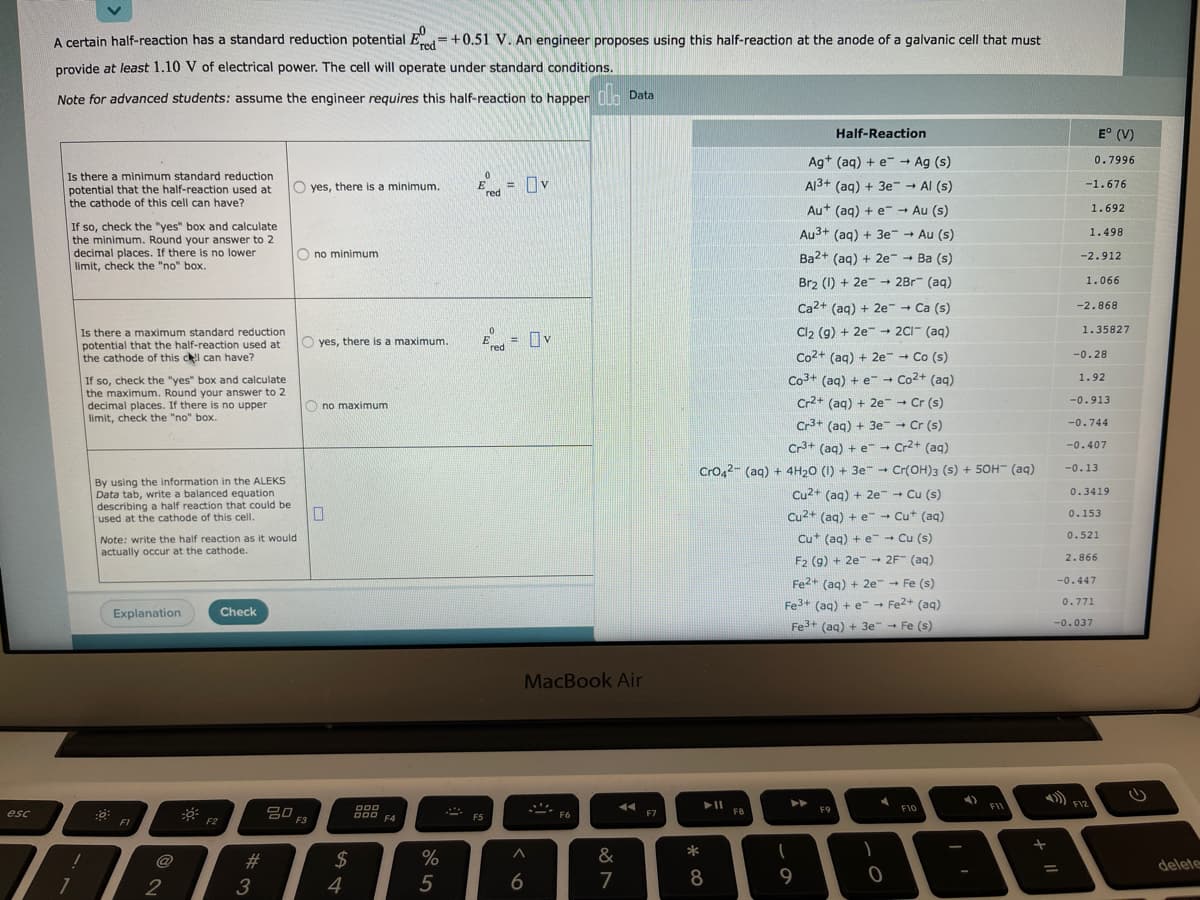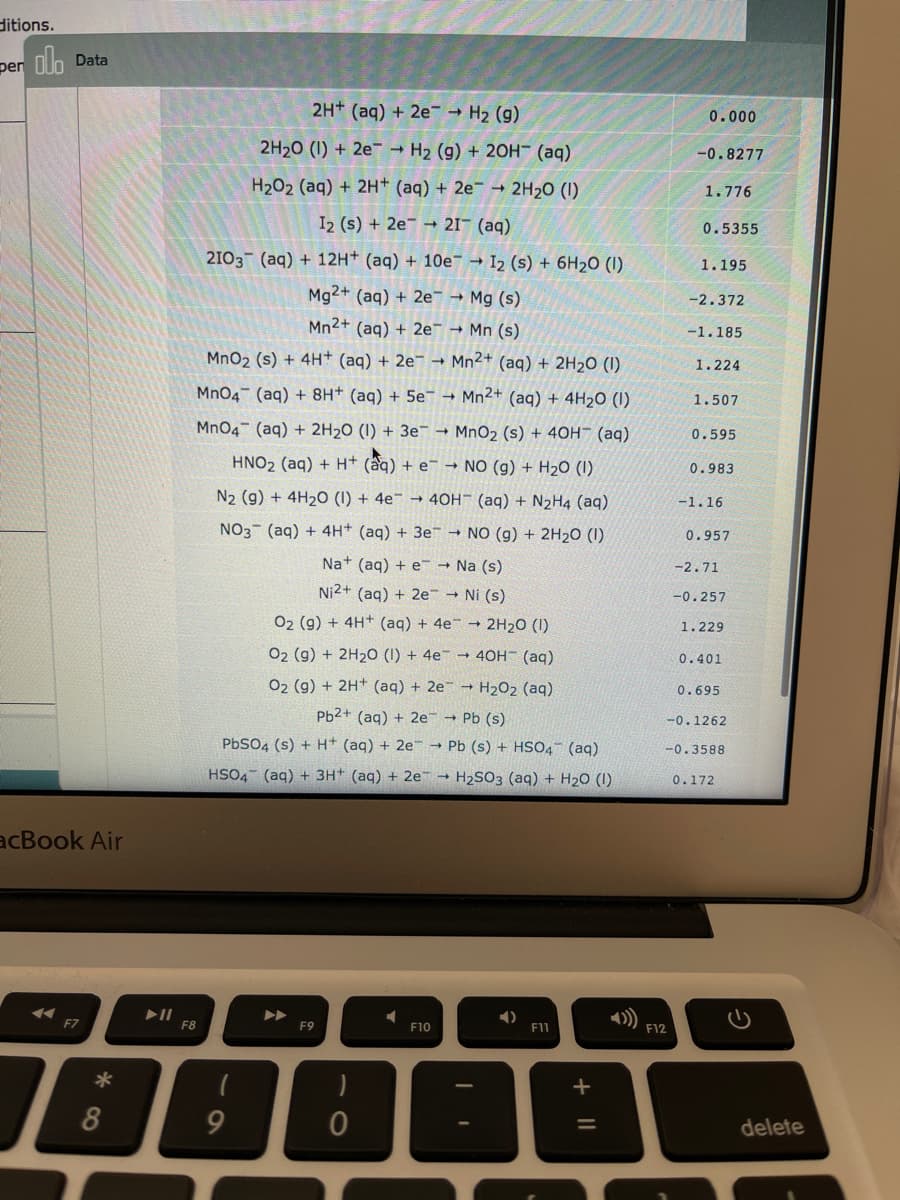A certain half-reaction has a standard reduction potential E=+0.51 V. An engineer proposes using this half-reaction at the anode of a galvanic cell that must 'red provide at least 1.10 V of electrical power. The cell will operate under standard conditions. Note for advanced students: assume the engineer requires this half-reaction to happer lo Data Half-Reaction Ag+ (aq) + e Ag (s) Is there a minimum standard reduction potential that the half-reaction used at the cathode of this cell can have? O yes, there is a minimum. = Ov Al3+ (aq) + 3e- → Al (s) %3D "red Aut (ag) + e- - Au (s) If so, check the "yes" box and calculate the minimum. Round your answer to 2 decimal places. If there is no lower limit, check the "no" box. Au3+ (ag) + 3e Au (s) O no minimum Ba2+ (aq) + 2e - - Ba (s) Br2 (1) + 2e- - 2Br (aq) Ca2+ (aq) + 2e Ca (s) Cl2 (9) + 2e - 2CI (aq) Is there a maximum standard reduction potential that the half-reaction used at the cathode of this cl can have? E- Ov O yes, there is a maximum. %3D red Co2+ (aq) + 2e- Co (s) If so, check the "yes" box and calculate the maximum. Round your answer to 2 decimal places. If there is no upper limit, check the "no" box. Co3+ (aq) + e - Co2+ (aq) Cr2+ (aq) + 2e → Cr (s) Cr3+ (aq) + 3e - Cr (s) O no maximum Cr3+ (aq) + e - Cr2+ (aq) Cro42- (aq) + 4H20 (1) + 3e - Cr(OH)3 (s) + 50H (aq) By using the information in the ALEKS Data tab, write a balanced equation describing a half reaction that could be used at the cathode of this cell. Cu2+ (aq) + 2e- Cu (s) Cu2+ (ag) + e- - Cut (aq) Note: write the half reaction as it would Cu* (aq) + e - Cu (s) actually occur at the cathode. F2 (9) + 2e 2F (aq) 2. Fe2+ (aq) + 2e - Fe (s) -0. Fe3+ (aq) + e - Fe2+ (aq) 0. Explanation Check -0. Fe3+ (aq) + 3e Fe (s)
A certain half-reaction has a standard reduction potential E=+0.51 V. An engineer proposes using this half-reaction at the anode of a galvanic cell that must 'red provide at least 1.10 V of electrical power. The cell will operate under standard conditions. Note for advanced students: assume the engineer requires this half-reaction to happer lo Data Half-Reaction Ag+ (aq) + e Ag (s) Is there a minimum standard reduction potential that the half-reaction used at the cathode of this cell can have? O yes, there is a minimum. = Ov Al3+ (aq) + 3e- → Al (s) %3D "red Aut (ag) + e- - Au (s) If so, check the "yes" box and calculate the minimum. Round your answer to 2 decimal places. If there is no lower limit, check the "no" box. Au3+ (ag) + 3e Au (s) O no minimum Ba2+ (aq) + 2e - - Ba (s) Br2 (1) + 2e- - 2Br (aq) Ca2+ (aq) + 2e Ca (s) Cl2 (9) + 2e - 2CI (aq) Is there a maximum standard reduction potential that the half-reaction used at the cathode of this cl can have? E- Ov O yes, there is a maximum. %3D red Co2+ (aq) + 2e- Co (s) If so, check the "yes" box and calculate the maximum. Round your answer to 2 decimal places. If there is no upper limit, check the "no" box. Co3+ (aq) + e - Co2+ (aq) Cr2+ (aq) + 2e → Cr (s) Cr3+ (aq) + 3e - Cr (s) O no maximum Cr3+ (aq) + e - Cr2+ (aq) Cro42- (aq) + 4H20 (1) + 3e - Cr(OH)3 (s) + 50H (aq) By using the information in the ALEKS Data tab, write a balanced equation describing a half reaction that could be used at the cathode of this cell. Cu2+ (aq) + 2e- Cu (s) Cu2+ (ag) + e- - Cut (aq) Note: write the half reaction as it would Cu* (aq) + e - Cu (s) actually occur at the cathode. F2 (9) + 2e 2F (aq) 2. Fe2+ (aq) + 2e - Fe (s) -0. Fe3+ (aq) + e - Fe2+ (aq) 0. Explanation Check -0. Fe3+ (aq) + 3e Fe (s)
Chemistry: An Atoms First Approach
2nd Edition
ISBN:9781305079243
Author:Steven S. Zumdahl, Susan A. Zumdahl
Publisher:Steven S. Zumdahl, Susan A. Zumdahl
Chapter17: Electrochemistry
Section: Chapter Questions
Problem 160MP
Related questions
Question

Transcribed Image Text:A certain half-reaction has a standard reduction potential E=+0.51 V. An engineer proposes using this half-reaction at the anode of a galvanic cell that must
'red
provide at least 1.10 V of electrical power. The cell will operate under standard conditions.
Note for advanced students: assume the engineer requires this half-reaction to happern lo Data
Half-Reaction
E° (V)
Ag+ (aq) + e- Ag (s)
0.7996
Is there a minimum standard reduction
potential that the half-reaction used at
the cathode of this cell can have?
= Ov
Al3+ (aq) + 3e → Al (s)
O yes, there is a minimum.
%3D
red
-1.676
Au+ (aq) + e - Au (s)
1.692
If so, check the "yes" box and calculate
the minimum. Round your answer to 2
decimal places. If there is no lower
limit, check the "no" box.
Au3+ (aq) + 3e Au (s)
1.498
O no minimum
Ba2+ (aq) + 2e-
+ Ba (s)
-2.912
Br2 (1) + 2e- -
2Br (aq)
1.066
Ca2+ (aq) + 2e + Ca (s)
-2.868
Cl2 (9) + 2e - 2CI- (aq)
1.35827
Is there a maximum standard reduction
potential that the half-reaction used at
the cathode of this cl can have?
E = Ov
O yes, there is a maximum.
red
Co2+ (aq) + 2e- Co (s)
-0.28
Co3+ (aq) + e - Co2+ (aq)
1.92
If so, check the "yes" box and calculate
the maximum. Round your answer to 2
decimal places. If there is no upper
limit, check the "no" box.
O no maximum
Cr2+ (aq) + 2e - Cr (s)
-0.913
Cr3+ (aq) + 3e - Cr (s)
-0.744
Cr3+ (aq) + e - Cr2+ (aq)
-0.407
Cro42- (aq) + 4H20 (1) + 3e - Cr(OH)3 (s) + 50H" (aq)
-0.13
By using the information in the ALEKS
Data tab, write a balanced equation
describing a half reaction that could be
used at the cathode of this cell.
Cu2+ (aq) + 2e Cu (s)
0.3419
Cu2+ (ag) + e- - Cut (ag)
0.153
Note: write the half reaction as it would
Cu* (aq) + e - Cu (s)
0.521
actually occur at the cathode.
F2 (9) + 2e - 2F (ag)
- 2F (aq)
2.866
Fe2+ (ag) + 2e Fe (s)
--0.447
Fe3+ (aq) + e - Fe2+ (ag)
0.771
Explanation
Check
Fe3+ (aq) + 3e - Fe (s)
-0.037
MacBook Air
FII
F12
DOD
D00 F4
F10
20
esc
F6
F7
F8
F9
F5
F1
F2
F3
@
#3
24
&
*
delete
2
4
6
8
9

Transcribed Image Text:ditions.
per olo Data
2H* (aq) + 2e- → H2 (g)
0.000
2H20 (1) + 2e- H2 (g) + 2OH (aq)
-0.8277
H202 (aq) + 2H* (aq) + 2e¯ → 2H20 (I)
1.776
I2 (s) + 2e - 21 (aq)
0.5355
2103 (aq) + 12H+ (aq) + 10e → I2 (s) + 6H20 (I)
1.195
Mg2+ (aq) + 2e Mg (s)
-2.372
Mn2+ (aq) + 2e¯ → Mn (s)
-1.185
MnO2 (s) + 4H* (aq) + 2e¯ → Mn2+ (aq) + 2H20 (I)
1.224
MnO4 (aq) + 8H+ (aq) + 5e- → Mn2+ (aq) + 4H2O (I)
1.507
Mn04 (aq) + 2H20 (1) + 3e → MnO2 (s) + 40H¯ (aq)
0.595
HNO2 (aq) + H+ (âq) + e¯ → NO (g) + H2O (1)
0.983
N2 (g) + 4H2O (1) + 4e¯ → 40H (aq) + N2H4 (aq)
-1.16
NO3 (aq) + 4H+ (aq) + 3e- → NO (g) + 2H20 (I)
0.957
Na+ (aq) + e - Na (s)
-2.71
Ni2+ (aq) + 2e - Ni (s)
-0.257
O2 (g) + 4H+ (aq) + 4e → 2H20 (1)
1.229
02 (g) + 2H2O (1) + 4e → 40H (aq)
0.401
O2 (g) + 2H+ (aq) + 2e H2O2 (aq)
0.695
Pb2+ (aq) + 2e → Pb (s)
-0.1262
PBSO4 (s) + H+ (aq) + 2e → Pb (s) + HSO4 (aq)
-0.3588
HSO4 (aq) + 3H+ (aq) + 2e H2SO3 (aq) + H20 (1)
0.172
acBook Air
II
F8
1)
F7
F9
F10
F11
F12
*
+
9.
delete
+ II
Expert Solution
This question has been solved!
Explore an expertly crafted, step-by-step solution for a thorough understanding of key concepts.
This is a popular solution!
Trending now
This is a popular solution!
Step by step
Solved in 3 steps with 3 images

Knowledge Booster
Learn more about
Need a deep-dive on the concept behind this application? Look no further. Learn more about this topic, chemistry and related others by exploring similar questions and additional content below.Recommended textbooks for you

Chemistry: An Atoms First Approach
Chemistry
ISBN:
9781305079243
Author:
Steven S. Zumdahl, Susan A. Zumdahl
Publisher:
Cengage Learning


Chemistry
Chemistry
ISBN:
9781305957404
Author:
Steven S. Zumdahl, Susan A. Zumdahl, Donald J. DeCoste
Publisher:
Cengage Learning

Chemistry: An Atoms First Approach
Chemistry
ISBN:
9781305079243
Author:
Steven S. Zumdahl, Susan A. Zumdahl
Publisher:
Cengage Learning


Chemistry
Chemistry
ISBN:
9781305957404
Author:
Steven S. Zumdahl, Susan A. Zumdahl, Donald J. DeCoste
Publisher:
Cengage Learning

Chemistry: Principles and Practice
Chemistry
ISBN:
9780534420123
Author:
Daniel L. Reger, Scott R. Goode, David W. Ball, Edward Mercer
Publisher:
Cengage Learning

Principles of Modern Chemistry
Chemistry
ISBN:
9781305079113
Author:
David W. Oxtoby, H. Pat Gillis, Laurie J. Butler
Publisher:
Cengage Learning

Chemistry: The Molecular Science
Chemistry
ISBN:
9781285199047
Author:
John W. Moore, Conrad L. Stanitski
Publisher:
Cengage Learning